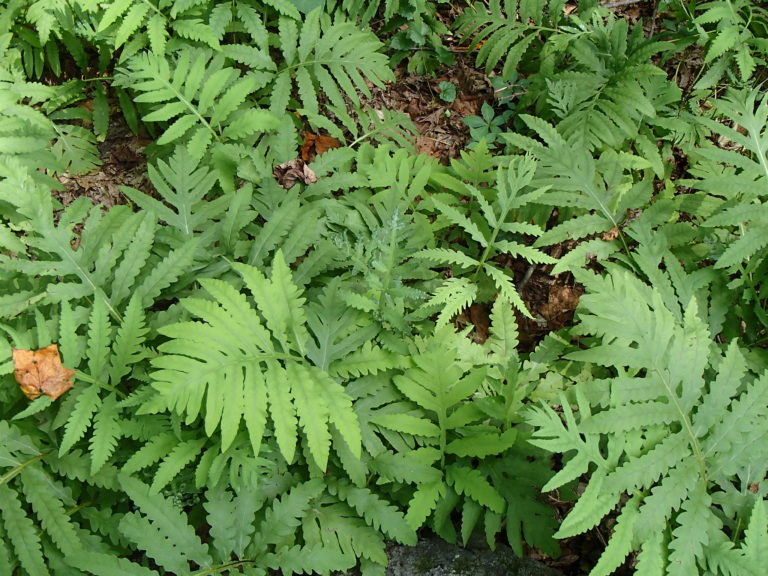Sensitive Fern is a very handsome, very vigorous, running deciduous perennial fern. It is “sensitive” only to the first frost in the late fall, and perhaps to drought — but very hardy otherwise! It is widely reported to be two- to three-foot tall and taller in wet soil, but we have never seen it taller than about 18 inches. Sensitive Fern has two types of fronds: the handsome, bright green, coarsely divided, leathery sterile fronds on long stalks, and shorter, non-green fertile (spore-bearing) fronds which brown up in the late summer and persists in the winter. The leathery texture of the sterile fronds contrasts nicely with the feathery effect of more finely divided fronds of other ferns. It tolerates dense shade and clay soils, and is very rarely touched by deer or other mammalian herbivores. It thrives in shady, evenly moist upland gardens where it will spread by both spores and rhizomes. Sensitive Fern can tolerate more sun if sufficient moisture is provided, but it will become yellowish and can become overly aggressive under these conditions. It has a very wide distribution — not only throughout central and eastern North America, but in East Asia as well, and has naturalized in western Europe. Properly sited, Sensitive Fern is an extremely attractive, lush and vigorous groundcover and has earned the Royal Horticultural Society’s Award of Garden Merit.
NURSERY HOURS
Wednesday: 10-4 Thursday: 10-6 Friday-Saturday: 10-4 Sunday: 12-4
Onoclea sensibilis

Key Info
Scientific Name: Onoclea sensibilis L.
Common Names: Sensitive fern, Bead Fern, Sympathy Fern
Family Names: Onocleaceae
Plant Type: Fern
Leaf Retention: Deciduous
Bloom Times: n/a
Flower Color: n/a
Special Characteristics: Good wildlife cover/habitat, Deer resistant, Tolerates Black Walnut, Attracts birds, Ornamental foliage, Rhizomatous, Tolerates shade, Reported to be deer resistant.
Additional Info
Habit: Single, stalked, sterile fronds emerge from a creeping rhizome creating ground-covering colonies. These are followed by fertile, upright, woody fronds which persist throughout the winter. The root system consists of a stout smooth, branching rhizome with spreading fibrous roots.
Height: 1'-2'
Spread: Indeterminate
Soil Conditions: Average to wet, organic; acidic to neutral pH; sandy, loamy, clay
Leaves: The sterile fronds, are triangular, 1-3' long including the petioles, and deeply lobed with opposite, well spaced lobes leaving the central stalk appearing "winged". They are gracefully shaped with smooth, wavy margins, the upper lobes arching upwards towards the tip and the lower lobes reaching downward. The fertile fronds -- See "Reproductive Structures".
Flowers (or reproductive structures: The fertile fronds are shorter than the sterile fronds, contracted to form hardened supports for the sporangia and their spores. They are erect, non-green, woody, very narrow pinnae to 12" tall, supporting bead-like sori ("Bead Fern"). They typically brown up in late summer and persist throughout the remaining season into winter, eventually releasing the spores to the wind.
Natural Distribution: Wet habitats, woodlands, thickets, meadows, bogs, stream and river banks, roadside ditches. Is usually found in habitats of moderate to high quality (Illinoiswildflower.info)
USDA Hardiness Zone: 4 to 8
USDA Wetland Indicator Status in NC: FACW
Wildlife Connections: Provides cover for small animals.
Propagation: By division or by spores.
